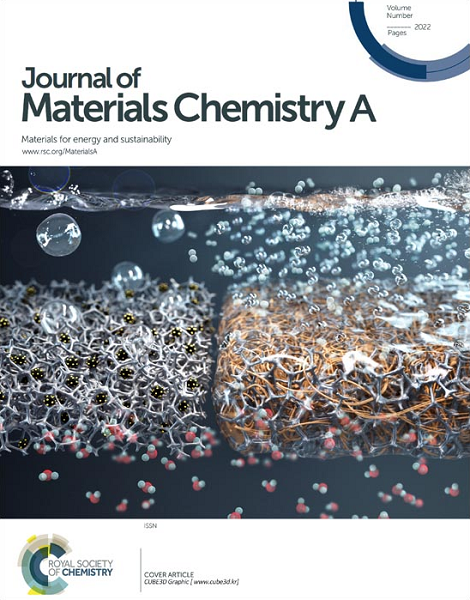Regulation of Transition Metal Atoms Supported on Defective h-BN by Adjacent Monovacancies for Electrochemical CO2 Reduction: Mechanism and d-band Spin-Polarization Effect
IF 10.7
2区 材料科学
Q1 CHEMISTRY, PHYSICAL
引用次数: 0
Abstract
Transition metal (TM)-doped defective hexagonal boron nitride (h-BN) single-atom catalysts (SACs) show significant promise for the electrochemical carbon dioxide reduction reaction (CO2RR). Given that defect engineering has emerged as a potent strategy for enhancing the catalytic performance of two-dimensional SACs and extensive experimental studies have observed that doping transition metals into defective two-dimensional substrates promotes the formation of adjacent vacancies, a comprehensive theoretical investigation is essential to elucidate the impact of different adjacent vacancies on the catalytic properties of TM-doped h-BN SACs. This study employs density functional theory calculations to investigate the regulatory effects and mechanisms of five types of adjacent boron and nitrogen monovacancies on the CO2RR catalytic performance of Fe, Co, and Mo atoms anchored on defective h-BN (denoted as M-vac@BN, where M = Fe, Mo, Co and vac = B1, B2, B3, N1, N2). Stability analysis reveals that the position and type of adjacent monovacancies significantly impact the stability of the supported metal atoms. Volcano plot and linear relationship analysis demonstrate that the CO adsorption energy (EB(CO)) serves as a reliable descriptor for predicting the overpotential for CO2RR on M-vac@BN. Strategic introduction of specific adjacent monovacancies can effectively tune the CO adsorption strength, thereby influencing the catalytic activity. More interestingly, a strong linear relationship is observed between the magnetic moments of transition metal atoms M in M-vac@BN (M = Co, Mo) and the integrated projected crystal orbital Hamiltonian population (IpCOHP) of the M-C bonds in CO adsorption intermediates, which arises from the linear relationship between the M-C bond strength in CO adsorption intermediate and the d-band spin polarization of the M atom in M-vac@BN. Specifically, enhanced d-band spin polarization strengthens the M-C bond by broadening the bonding peak in the projected crystal orbital Hamiltonian population (pCOHP) of the M-C bond.邻单空位对缺陷h-BN上过渡金属原子在电化学CO2还原中的调控:机理和d带自旋极化效应
过渡金属(TM)掺杂缺陷六方氮化硼(h-BN)单原子催化剂(SACs)在电化学二氧化碳还原反应(CO2RR)中具有重要的应用前景。鉴于缺陷工程已经成为提高二维SACs催化性能的有效策略,并且大量的实验研究已经观察到,在有缺陷的二维衬底中掺杂过渡金属促进相邻空位的形成,因此有必要进行全面的理论研究,以阐明不同相邻空位对tm掺杂h-BN SACs催化性能的影响。本研究采用密度泛函理论计算,研究了五种相邻的硼氮单空位对锚定在缺陷h-BN上的Fe、Co和Mo原子的CO2RR催化性能的调节作用及其机制(表示为M-vac@BN,其中M = Fe、Mo、Co, vac = B1、B2、B3、N1、N2)。稳定性分析表明,相邻单空位的位置和类型对支撑金属原子的稳定性有显著影响。火山图和线性关系分析表明,CO吸附能(EB(CO))可作为预测M-vac@BN上CO2RR过电位的可靠描述符。有策略地引入特定相邻单空位可以有效调节CO吸附强度,从而影响催化活性。更有趣的是,在M-vac@BN (M = Co, Mo)中,过渡金属原子M的磁矩与Co吸附中间体中M- c键的集成投影晶体轨道哈密顿居群(IpCOHP)之间存在很强的线性关系,这是由于Co吸附中间体中M- c键强度与M-vac@BN中M原子的d带自旋极化之间存在线性关系。具体来说,增强的d波段自旋极化通过拓宽M-C键的投影晶体轨道哈密顿居群(pCOHP)中的键峰来增强M-C键。
本文章由计算机程序翻译,如有差异,请以英文原文为准。
求助全文
约1分钟内获得全文
求助全文
来源期刊

Journal of Materials Chemistry A
CHEMISTRY, PHYSICAL-ENERGY & FUELS
CiteScore
19.50
自引率
5.00%
发文量
1892
审稿时长
1.5 months
期刊介绍:
The Journal of Materials Chemistry A, B & C covers a wide range of high-quality studies in the field of materials chemistry, with each section focusing on specific applications of the materials studied. Journal of Materials Chemistry A emphasizes applications in energy and sustainability, including topics such as artificial photosynthesis, batteries, and fuel cells. Journal of Materials Chemistry B focuses on applications in biology and medicine, while Journal of Materials Chemistry C covers applications in optical, magnetic, and electronic devices. Example topic areas within the scope of Journal of Materials Chemistry A include catalysis, green/sustainable materials, sensors, and water treatment, among others.
 求助内容:
求助内容: 应助结果提醒方式:
应助结果提醒方式:


